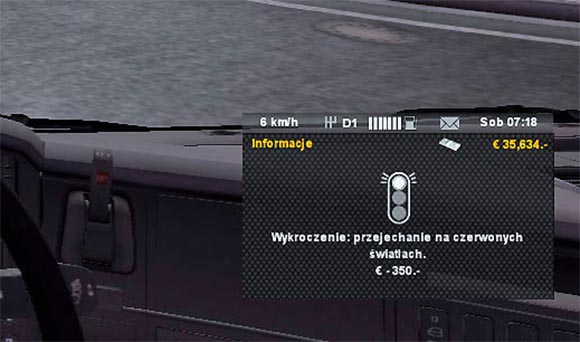This is perhaps a bit old but here is an observation I had recently. I have encountered two games that model car traffic violations in different ways. One is GTA, the other one is Euro Truck Simulator 2.
Most of us are familiar with the way GTA models Traffic Violations – players have a wanted-meter represented by a row of stars. Whenever they commit some offense the meter goes up. As the meter rises, more and more police units are chasing after the player trying to arrest them.

Wanted level in GTA
In comparison, the way Euro Truck Simulator 2 handles things is a lot simpler. Every time the player commits an offense, they get a message and a sum of money gets automatically deducted from their in-game account. Players don’t need to even stop or interact with the police in any way.

Running the red light in Euro Truck – a passive message on the Satnav. You don’t even need to stop.
So in GTA, dealing with the punishment for an offense is almost a game in itself. A player might be doing a mission, accidentally commit an offense and the mission would spiral out of control into a spontaneous cops-and-robbers chase across town. For many players, this is a main draw of the game. They often actually exploit this system to challenge themselves to survive the ever increasing onslaught of police units. The punishment for the crime is actually not really a punishment – it is often a source of fun and enjoyment. Euro Truck Simulator 2, on the other hand, minimizes any intrusions in the core gameplay of driving a truck from point A to point B. The punishment is delivered passively and discreetly. Players don’t have to act upon it in other ways that actually prevent it. Also, the punishment is real – there is nothing fun or engaging about losing money in that game.
But there is more. You see, GTA doesn’t ACTUALLY model traffic violations. The only way players can get into troubles is by crashing into a police car or running over a pedestrian. Cashing into other cars, running red lights, driving to fast or on the wrong side of the road is never punished – even if there is a police car present and watching. Euro Truck Simulator 2 does pay attention to all these things no matter if there is a police car involved or not.
Here, we see a reversal of philosophies. GTA chooses not to simulate ordinary traffic violations, presumably in order to maintain a free-roaming sandbox feel of the game. In Euro Truck Simulator 2, driving according to the rules IS the game. It is a source of enjoyment and an expected feature in a simulation title.
The reason why the same aspect of traffic violations is seen as a feature in one game and a hindrance in another is, because the two games are trying to convey different experiences. GTA wants to put players into the shoes of a Hollywood criminal – always on the run from the police while standing above the pedantic laws of commute traffic. Euro Truck Simulator 2 wants to put you in the shoes of a regular truck driver, who lives in a world governed by traffic and it’s laws.
Finally, it is interesting to note that, Euro Truck Simulator 2 does stray into wish-fulfillment in two aspects:
-
As already mentioned, the payment for traffic ticket occurs automatically and without any interaction. In reality, dealing with the paperwork is a nuisance it itself, often more aggravating and punishing than the actual sum to be paid. Euro Truck Simulator 2 streamlines this process to an extent many of us would probably wish for. You get a message on your Satnav and just keep on trucking.
-
On a more serious note, the monetary punishment of traffic offenses becomes less of a setback, the more money players have. In the end-game, players earn so much money from AI drivers, they can actually chose to completely disobey any traffic laws and live the GTA life. This results in the accidental rhetoric that wealth allows a person to set themselves above the law. Or more polemically – that wealth leads to crime.
I find it noteworthy that even though both games could be categorized as “open-world driving”, they follow very different design strategies. There is no obvious superior strategy here, it really depends on what kind of experience a designer wants to convey. But it’s good to see a game like Euro Truck Simulator 2 in order to remind yourself that certain aspects of a simulation can and maybe should be abstracted away or at least solved differently. On a closing note, the realistic portrayal of traffic rules resulted in far more uncanny game / IRL confusion situations for me. When driving in the car after longer trucking sessions, I often caught myself slipping into the Euro Truck Simulator 2 mindset when at the wheel of an actual car.






I find it interesting, especially since several countries in Europe have changed to fines based upon the perceived income of the offender – which would be a logical outcome of trying to prevent the ‘gaming’ of that rule set.